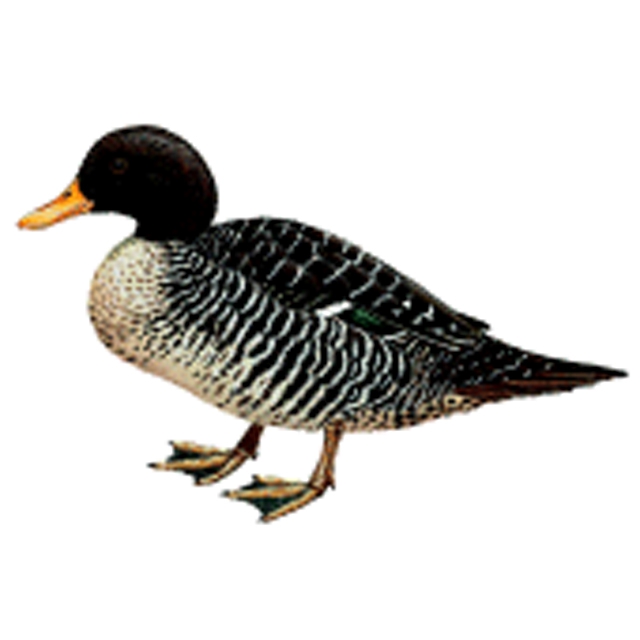| Citation |
BirdLife International. 2016. Salvadorina waigiuensis. The IUCN Red List of Threatened Species 2016: e.T22680127A92845212. https://dx.doi.org/10.2305/IUCN.UK.2016-3.RLTS.T22680127A92845212.en. Downloaded on 19 June 2020. |
Description |
JUSTIFICATION
This species is widespread, from the low foothills to the highest alpine tarns; but it appears to have a small population size because of its specialised habitat requirements. It is likley to be slowly declining through hunting and habitat degradation and therefore qualifies as Vulnerable, although further information may show that it it has a larger population size and is less threatened than currently thought.
RANGE DESCRIPTION
Salvadorina waigiuensis is endemic to the mountains of New Guinea (Papua, formerly Irian Jaya, Indonesia and Papua New Guinea). There are records at 70 m in the Lakekamu Basin, but it rare and local at lower altitudes. It occurs across the island in suitable montane habitat and was recorded at 4,300 m on five occasions in 2010 (Sam and Koane 2013). The population has been variously estimated to be 2,500-20,000 birds and stable or slowly declining (Callaghan and Green 1993). The species has been observed using an ephemeral lake at 1650 m in the Foja Mts of western New Guinea (2005, 2008) (B. Beehler in litt. 2012), indicating that it can cross expanses of closed forest in search of suitable habitat.
DESCRIPTION
The total population is estimated to number 2,500-20,000 individuals,and is thus best placed in the band 2,500-9,999 mature individuals. In reality, the population is likely to be higher.
Trend Justification: Some local extinctions have been recorded and the species as a whole is suspected to be declining at a slow rate, owing to hunting, predation by dogs and habitat degradation (Coates 1985, Callaghan and Green 1993).
HABITAT AND ECOLOGY
Although recorded from 70-4,300 m, this duck is uncommon below 600 m and is most common at the highest altitudes (Coates 1985, Beehler et al. 1986, Callaghan and Green 1993, J. Hornbuckle in litt 1999, Beehler and Pratt 2016). It breeds beside fast-flowing rivers and streams, and alpine lakes, and has also been recorded on slow-flowing rivers (Coates 1985, Callaghan and Green 1993). It is not sociable, and one rarely encounters anything beside single adults or pairs (B. Beehler in litt. 2007, Pratt & Beehler 2015). Breeding territories are variable in size owing to local conditions, for instance pairs have been found to occupy 1,600 m of stream on the Baiyer River (Kear 1975) but only 160 m on the Ok Menga River (Bell 1969). The species uses small tributary streams as well as main river channels, a factor which may contribute to its perceived rarity. It lays clutches of two to four eggs alongside rivers or lakes in the dry season (Kear 1975). It is omnivorous, feeding on aquatic invertebrates, tadpoles and plants by dabbling and diving (Kear 1975, Coates 1985, Pratt & Beehler 2015).
THREATS
Some local extirpations and declines have been attributed to hunting (Bishop 1987, K. D. Bishop in litt. 1994), predation by dogs, and habitat degradation, largely through increasing human pressure and siltation, especially from hydroelectric projects, mining and logging (Murray 1988, A. Mack in litt 1999, Callaghan in prep.), but these have only impacted small areas (B. Whitney in litt. 2000). The stocking of alpine rivers with exotic trout species has been suggested as a potential risk to food sources (Kear 1975, Callaghan and Green 1993).
CONSERVATION ACTIONS
Conservation Actions Underway
This species is protected by law in Papua New Guinea (Callaghan and Green 1993). It is known to be fairly common within the Crater Mountain Wildlife Management Area where it has been a focus of specific study (Straus 2006).
Conservation Actions Proposed
Determine best survey techniques and survey a sample of rivers throughout the range, including areas with varying human population pressure and other factors, such as those upstream and downstream of hydroelectric, mining and logging activities and those with high numbers of trout. Research ecology on both lakes and rivers. Assess hunting pressure through discussion with local hunters. Address hunting through public awareness programmes. Assess scale of other threats. |

